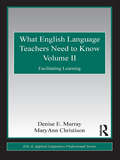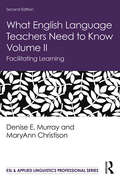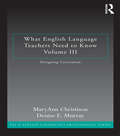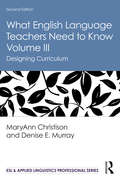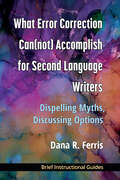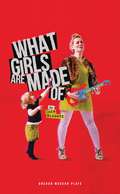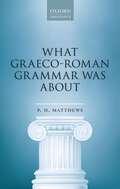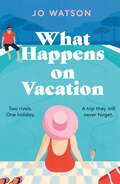- Table View
- List View
What English Language Teachers Need to Know Volume II: Facilitating Learning
by Denise E. Murray MaryAnn ChristisonDesigned for pre-service teachers and teachers new to the field of ELT, Volume II and its companion are companion textbook, Volume I, are volumes organized around the key question: What do teachers need to know and be able to do in order for their students to learn English? Volume I covers the characteristics of the context in which teachers work, how English works and how it is learned, and the teacher’s role in the larger professional sphere of English language education. Volume II covers the three main facets of teaching: planning, instructing, and assessing. The focus throughout is on outcomes, that is, student learning. The texts work for teachers across different contexts (countries where English is the dominant language, one of the official languages, or taught as a foreign language); different levels (elementary/primary, secondary, college or university, or adult education), and different learning purposes (general English, workplace English, English for academic purposes, or English for specific purposes).
What English Language Teachers Need to Know Volume II: Facilitating Learning
by Denise E. Murray MaryAnn ChristisonDesigned for pre-service teachers and teachers new to the field of ELT, Volume II and its companion are companion textbook, Volume I, are volumes organized around the key question: What do teachers need to know and be able to do in order for their students to learn English? Volume I covers the characteristics of the context in which teachers work, how English works and how it is learned, and the teacher’s role in the larger professional sphere of English language education. Volume II covers the three main facets of teaching: planning, instructing, and assessing. The focus throughout is on outcomes, that is, student learning. The texts work for teachers across different contexts (countries where English is the dominant language, one of the official languages, or taught as a foreign language); different levels (elementary/primary, secondary, college or university, or adult education), and different learning purposes (general English, workplace English, English for academic purposes, or English for specific purposes).
What English Language Teachers Need to Know Volume II: Facilitating Learning (ESL & Applied Linguistics Professional Series)
by Denise E. Murray MaryAnn ChristisonDesigned for pre-service teachers and teachers new to the field of ELT, Volume II of the What English Language Teachers Need to Know set covers the three main facets of teaching: planning, instructing, and assessing. Updated with new research throughout, the focus throughout is on outcomes, that is, student learning. The texts work for teachers across different contexts; different levels, and different learning purposes. The Second Edition has expanded to address corpus-based data, new technologies, and a wider range of contexts.
What English Language Teachers Need to Know Volume II: Facilitating Learning (ESL & Applied Linguistics Professional Series)
by Denise E. Murray MaryAnn ChristisonDesigned for pre-service teachers and teachers new to the field of ELT, Volume II of the What English Language Teachers Need to Know set covers the three main facets of teaching: planning, instructing, and assessing. Updated with new research throughout, the focus throughout is on outcomes, that is, student learning. The texts work for teachers across different contexts; different levels, and different learning purposes. The Second Edition has expanded to address corpus-based data, new technologies, and a wider range of contexts.
What English Language Teachers Need to Know Volume III: Designing Curriculum
by MaryAnn Christison Denise E. MurrayWhat English Teachers Need to Know, a set of companion texts designed for pre-service teachers and teachers new to the field of ELT, addresses the key question: What do English language teachers need to know and be able to do in order for their students to learn English? These texts work for teachers across different contexts (countries where English is the dominant language, one of the official languages, or taught as a foreign language); different levels (elementary/primary, secondary, college or university, or adult education); and different learning purposes (general English, workplace English, English for academic purposes, or English for specific purposes). Volume I, on understanding learning, provides the background information that teachers need to know and be able to use in their classroom. Volume II, on facilitating learning, covers the three main facets of teaching: planning, instructing, and assessing. Volume III, on designing curriculum, covers the contexts for, processes in, and types of ELT curricula—linguistic based, content-based, learner-centered, and learning-centered. Throughout the three volumes, the focus is on outcomes, that is, student learning. Features • Situated in current research in the field of English language teaching and other disciplines that inform it • Sample data, including classroom vignettes • Three kinds of activities/tasks: Reflect, Explore, and Expand
What English Language Teachers Need to Know Volume III: Designing Curriculum
by MaryAnn Christison Denise E. MurrayWhat English Teachers Need to Know, a set of companion texts designed for pre-service teachers and teachers new to the field of ELT, addresses the key question: What do English language teachers need to know and be able to do in order for their students to learn English? These texts work for teachers across different contexts (countries where English is the dominant language, one of the official languages, or taught as a foreign language); different levels (elementary/primary, secondary, college or university, or adult education); and different learning purposes (general English, workplace English, English for academic purposes, or English for specific purposes). Volume I, on understanding learning, provides the background information that teachers need to know and be able to use in their classroom. Volume II, on facilitating learning, covers the three main facets of teaching: planning, instructing, and assessing. Volume III, on designing curriculum, covers the contexts for, processes in, and types of ELT curricula—linguistic based, content-based, learner-centered, and learning-centered. Throughout the three volumes, the focus is on outcomes, that is, student learning. Features • Situated in current research in the field of English language teaching and other disciplines that inform it • Sample data, including classroom vignettes • Three kinds of activities/tasks: Reflect, Explore, and Expand
What English Language Teachers Need to Know Volume III: Designing Curriculum (ESL & Applied Linguistics Professional Series)
by MaryAnn Christison Denise E. MurrayDesigned for pre-service and novice teachers in ELT, What English Language Teachers Need to Know Volumes I, II, and III are companion textbooks organized around the key question: What do teachers need to know and be able to do in order to help their students to learn English?Thoroughly revised and updated, the second edition of Volume III explores the contexts for ELT curricula; explains key processes in curriculum design; and sets out approaches to curricula that are linguistic-based, content-based, learner centered, and learning centered. Organized around the three pillars of teaching—planning, instructing, and assessing—chapters in the second edition are updated to include current research and theory to meet the needs of today’s teachers, and feature new or revised vignettes and activities. New chapters help teachers understand both the technological and multilingual approaches that learners need to succeed today. The comprehensive texts of this series are suitable resources for teachers across different contexts—where English is the dominant language, an official language, or a foreign language; for different levels—elementary/primary, secondary, university, or adult education; and for different learning purposes—general English, workplace English, English for academic purposes, or English for specific purposes.
What English Language Teachers Need to Know Volume III: Designing Curriculum (ESL & Applied Linguistics Professional Series)
by MaryAnn Christison Denise E. MurrayDesigned for pre-service and novice teachers in ELT, What English Language Teachers Need to Know Volumes I, II, and III are companion textbooks organized around the key question: What do teachers need to know and be able to do in order to help their students to learn English?Thoroughly revised and updated, the second edition of Volume III explores the contexts for ELT curricula; explains key processes in curriculum design; and sets out approaches to curricula that are linguistic-based, content-based, learner centered, and learning centered. Organized around the three pillars of teaching—planning, instructing, and assessing—chapters in the second edition are updated to include current research and theory to meet the needs of today’s teachers, and feature new or revised vignettes and activities. New chapters help teachers understand both the technological and multilingual approaches that learners need to succeed today. The comprehensive texts of this series are suitable resources for teachers across different contexts—where English is the dominant language, an official language, or a foreign language; for different levels—elementary/primary, secondary, university, or adult education; and for different learning purposes—general English, workplace English, English for academic purposes, or English for specific purposes.
What Error Correction Can(not) Accomplish for Second Language Writers: DIspelling Myths, Discussing Options
by Dana R. FerrisThis book looks at aspects of L2 research that influence error correction, finding that second language acquisition takes time and that second language writers' texts differ from those written by native English speakers. Using this research, Dana R. Ferris dispels the myth that diligent teacher correction and student editing can lead to perfect, error-free texts. In clear and simple terms, Ferris makes six suggestions for things teachers can do in the classroom regarding error correction and provides samples. Other issues regarding the expectations of students and others—such as in timed (high-stakes) situations—as it relates to "perfect" papers are examined. The book closes by addressing the basic principles of developing students' language skills in second language/ESL writing classes.
What Every Novelist Needs to Know about Narrators (Chicago Shorts)
by Wayne C. BoothWayne Booth transformed the study of fiction in the twentieth century and wrote some of the most influential and engaging criticism of our time. In What Every Novelist Needs to Know about Narrators, Booth tackles one of the most difficult issues writers of fiction face: the choice of which narrative approach to take in their work. With trademark Booth aplomb, he articulates the methods behind dramatization, character development, and point of view that are indispensable for successful writing. How far the narrator sees, how she or he thinks, and how those thoughts connect with—or diverge from—those of the reader, writer, or other characters in the story: these are tools that are key to narration, and here Booth considers them in this worthy selection.
What Forms Can Do: The Work of Form in 20th- and 21st- Century French Literature and Thought (Contemporary French and Francophone Cultures #69)
This volume responds to important questions about the formal properties of literary texts and the agency of form. A central feature of twentieth- and twenty-first century French and Francophone writing has been the exploration of how cultural forms (literary, philosophical and visual) create distinctive semiotic environments and at the same time engage powerfully with external realities. How does form propose a bridge between the environment of the text and the world beyond? What kinds of formal innovations have authors devised in response to the complexity of that world? How do the formal properties of texts inflect our reading of them, and perhaps also our apprehension of the real? In addressing such questions as they apply to a wide corpus of texts, including the novel, life writing, the essay, travel writing, poetry and textual/visual experiments, the chapters in this volume offer new perspectives on a wide range of creative figures including Proust, Picasso, Breton, Bataille, Ponge, Guillevic, Certeau, Camus, Barthes, Perec, Roubaud, Chauvet, Savitzkaya, Eribon, Ernaux, Laurens and Akerman. Collectively, they renew the engagement with form that has been a key feature of French cultural production and of analysis in French studies.
What Girls Are Made Of (Oberon Modern Plays)
by Cora BissettIt’s 1992. In a small town in Fife, a girl is busting to get out into the world and see what's on offer. And an ad in the local paper declares: BAND SEEKS SINGER.Grunge has just gone global, scruffy indie kids are inheriting the earth, and a schoolgirl from Glenrothes is catapulted to a rock star lifestyle as the singer in a hot new indie band. Touring with Radiohead, partying with Blur, she was living the dream. Until she wasn’t.Based on her meticulously detailed, pull-no-punches teenage diaries, this is the true story of Cora Bissett’s rollercoaster journey from the girl she was to the woman she wanted to be.
What Graeco-Roman Grammar Was About
by P. H. MatthewsThis book explains how the grammarians of the Graeco-Romance world perceived the nature and structure of the languages they taught. The volume focuses primarily on the early centuries AD, a time when the Roman Empire was at its peak; in this period, a grammarian not only had a secure place in the ancient system of education, but could take for granted an established technical understanding of language. By delineating what that ancient model of grammar was, P. H. Matthews highlights both those aspects that have persisted to this day and seem reassuringly familiar, such as 'parts of speech', as well as those aspects that are wholly dissimilar to our present understanding of grammar and language. The volume is written to be accessible to students of linguistics from undergraduate level upwards, and assumes no knowledge of Latin or Ancient Greek.
What Happens On Vacation: The brand-new enemies-to-lovers rom-com you won't want to go on holiday without!
by Jo WatsonTwo rivals. One holiday. A trip they will never forget.Jo Watson returns with a hilarious and heartfelt new enemies-to-lovers, forced-proximity rom-com! It's the book you won't want to go on holiday without! Perfect for fans of Emily Henry, Beth O'Leary and Christina Lauren..........................................Journalist Margaret needs a vacation. After a difficult couple of years, some R&R is on the cards, and she's taking her mom with her. Luckily, the office Quiz Night is coming up and the prize is an all-expenses-paid trip to Zanzibar. Good thing Margaret has never met a quiz question she didn't like. But Margaret has also never played against Jagger Villain. For the last six months, they have shared a desk and not a day has gone by when he hasn't driven her to distraction. The idea of sharing anything else with Jagger is unthinkable. But if she's going get what she needs from this trip, Margaret might have to compromise. Away from the office and in a tropical paradise, Margaret beings to wonder if her archnemesis maybe has some qualities. Could the holiday from hell turn into the vacation of her dreams? .........................................Love funny, romantic stories? You don't want to miss Jo Watson:'The perfect choice for fans of romantic comedies' Gina's Bookshelf'It was amazing, it was hilarious' Rachel's Random Reads'A brilliant read from beginning to end' Hopeless Romantics'Sitting here open mouthed in disbelief at just how wonderful this book is' Rachel's Random Reads'A stunning heart-warming read' Donna's Book Blog
What Ho! P. G. Wodehouse on Cats & Dogs: And Other Animals (What Ho! P. G. Wodehouse)
by Paul KentIt was a confusion of ideas between him and one of the lions he was hunting in Kenya that had caused A.B. Spottsworth to make the obituary column. He thought the lion was dead, and the lion thought it wasn't. Whether you're a fan of cats, dogs, lions or even gnus, P. G. "Plum" Wodehouse has got your back. A lifelong animal-lover, he even founded a shelter for strays – in addition to the pack of pekes, dachshunds, wolfhounds, cats, parrots and canaries that overran his home. Which is not to mention the cassowaries, gorillas, horses, snakes, rabbits, chimpanzees, alligators, newts, swans, and pigs that populate his masterful comedies. The sixth of Paul Kent's occasional essays on matters Wodehousean features the entire menagerie. But it's the dogs and cats (along with their respective owners and staff) that are the real stars. Whichever claims your loyalty, with Wodehouse you're bound to see their funny side.
What Ho! P. G. Wodehouse on Childhood (What Ho! P. G. Wodehouse)
by Paul Kent"What are the chances of a cobra biting Harold, Jeeves?" "Slight, I should imagine, sir. And in such an event, knowing the boy as intimately as I do, my anxiety would be entirely for the snake." Children – or should we say "fiends in human shape" – tend to get a raw deal in the hilarious tales of P. G. "Plum" Wodehouse, coming out with things like "Daddee, are daisies little bits of the stars that have been chipped off by the angels?" or even "You've got a face like a fish!" When not turning the brains of normally sane, rational adults into soppy, sentimental lumps of blancmange, they are actually noisy, messy, cunning, and even venomous. The ninth of Paul Kent's occasional essays on matters Wodehousean is a fascinating tour through Plum's alternative brand of tongue-in-cheek pedagogy, and a timely reminder that lurking somewhere in our adult selves is the child we all once were.
What Ho! P. G. Wodehouse on Class (What Ho! P. G. Wodehouse)
by Paul Kent"I am not very well up in the Peerage. I seldom read it except to get a laugh out of the names." P. G. "Plum" Wodehouse rarely stood on ceremony, and the snooty English class system was a favourite target for his satire. A demolisher of privilege, pretension and snobbery, Plum presents us with a cavalcade of potty peers, dotty dowagers and perfidious plutocrats who anatomize the nation's social hierarchy more successfully than the fieriest political orator could ever manage – and all the while making us laugh. The fourth of Paul Kent's occasional essays on matters Wodehousean takes us on a hilarious tour round 20th-century English society, proving time and again that in Plum's world rank is but a guinea stamp, and kind hearts are always worth more than coronets.
What Ho! P. G. Wodehouse on Faith (What Ho! P. G. Wodehouse)
by Paul KentSo you've won the Scripture-knowledge prize, have you?""Sir, yes, sir.""Yes," said Gussie, "you look just the sort of little tick who would." P. G. "Plum" Wodehouse has been described as "strenuously agnostic", yet he still wrote brilliantly, affectionately – and hilariously – about the Anglican Church. Brimming with over 50 clergymen of every rank (including the Reverends 'Pieface' Brandon and Sidney Potter-Pirbright who looks like he's been stuffed by an inexperienced taxidermist), his stories also contain over 2,300 quotations from the King James Bible, proving Plum knew his Acts from his Ezekiel. The tenth of Paul Kent's occasional essays on matters Wodehousean takes us on a joyous journey from Plum's childhood visits to his four clerical uncles, to his later attendance at séances and his none-too serious musings on the Hereafter ("we'll have to wait and see"). Proof, if proof were needed that in Wodehouse World nothing, but nothing is sacred.
What Ho! P. G. Wodehouse on Fashion (What Ho! P. G. Wodehouse)
by Paul Kent"There are moments, Jeeves, when one asks oneself, 'Do trousers matter?'""The mood will pass, sir." Not only do trousers matter in the crazy world of P. G. "Plum" Wodehouse, they speak volumes: as does one's choice of suit, shirt, cuffs, studs, collar, tie, socks, shoes, spatterdashes, hat and stick. Jeeves, Bertie Wooster's "infallible" valet, is always there to guide us through this sartorial minefield, his trained eye able to spot the microscopic detail that separates the chic, de rigueur, and le dernier cri from the outré and farouche. The seventh of Paul Kent's occasional essays on matters Wodehousean takes us on a fascinating and informative tour of what the well-dressed man (and woman) should wear in order to look just right, transporting us back to an era of top hats, white ties and tailoring that positively reeks with 1920s and 30s elegance.
What Ho! P. G. Wodehouse on Food (What Ho! P. G. Wodehouse)
by Paul Kent"Wooster", those who know me have sometimes said, "may be a pretty total loss during the daytime hours, but plunge the world in darkness, switch on the soft lights, uncork the champagne and shove a dinner into him, and you'd be surprised."The hilarious fictional world of P. G. "Plum" Wodehouse is a gourmand's paradise. From Bertie Wooster demolishingSylphides à la Crème d'Écrevisses, to Lord Emsworth tucking into a well-jammed roly-poly pudding, to a schoolboy toasting a muffin at the study fire, "browsing and sluicing" is not simply eating and drinking but a daily celebration of being alive. How many other writers actually make their readers feel hungry? Plum can ... and does, while alerting them to the perils of over-consumption, dieting and food fads. So grab yourself a half bot of something half decent and settle back with this, the first of Paul Kent's occasional amuse-bouches on Wodehousean themes. Bon appétit!
What Ho! P. G. Wodehouse on Hollywood (What Ho! P. G. Wodehouse)
by Paul Kent"It isn't half such a crazy place as it's made out to be. I know two- three people in Hollywood that are part sane." A talking gorilla called Cyril who graduated from Oxford University; a sword-wielding diva driven crazy by her orange juice diet; an English milord swapping bodies with a gobby 12 year-old film star – these are screwball plots even by P. G. 'Plum' Wodehouse's brilliant comic standards. But not so surprising when we learn they take place in "the weirdest place" he had ever worked – Hollywood. Paul Kent's eighth essay on matters Wodehousean is a backstage pass to "Dottyville-on-the-Pacific's" Golden Age in the 1930's, replete with glamour, glitter and the monstrous egos of its biggest movers and shakers. You'll be SHOCKED! You'll be THRILLED! – but above all, you'll be ENTERTAINED!
What Ho! P. G. Wodehouse on Love (What Ho! P. G. Wodehouse)
by Paul Kent"Jeeves, I'm engaged." "I hope you will be very happy, sir." "Don't be an ass. I'm engaged to Miss Bassett." P. G. "Plum" Wodehouse was the father of the modern rom-com. In his hilarious fictional world, love is all around, in the air and a many-splendoured thing. It's a fact of life, ready and waiting to be fallen in and out of by his men and women, be they willing volunteers, helpless victims, or, like Bertie Wooster, sprinting in the opposite direction ("The voice of Love seemed to call to me, but it was a wrong number.") The third of Paul Kent's occasional essays on matters Wodehousean leads us on a merry dance up those three steps to heaven, guiding us through some of the funniest and unlikely love stories ever written. An ideal present, in fact, for the love of your life.
What Ho! P. G. Wodehouse on Money (What Ho! P. G. Wodehouse)
by Paul Kent"[I'm] as broke as the ten commandments." P. G. "Plum" Wodehouse knew a thing or two about the money-go-round; in 1938 he was the world's highest paid writer. At times, his financial affairs read like one of his own comic plots, as British and American tax inspectors chased him from pillar to post across two continents. Many of his characters are similarly afflicted: but whether they have too much or too little splosh in the old sock, they always seem to learn – in the funniest ways possible – that money is an excellent servant and a terrible master. The fifth of Paul Kent's occasional essays on matters Wodehousean is packed with paupers and plutocrats, meritocrats and misers all mooching with Mammon. It most certainly is funny in this rich man's world!
What Ho! P. G. Wodehouse on Sport (What Ho! P. G. Wodehouse)
by Paul Kent"To the philosophical student of golf like myself" (said the Oldest Member), perhaps the most outstanding virtue of this noble pursuit is the fact that it is a medicine for the soul." Sport, in the hilarious fictional world of P. G. "Plum" Wodehouse, is not exclusively about sweaty blokes in shorts, flannels or garish pullovers. Because they're only incidentally about the game in question, just about any-one, sports fan or not, can read his tales of the ring, pitch or links with unalloyed pleasure. So when he writes about cricket, rugby or golf, it's not all runs, tries and holes-in-one but friendship, competitiveness, and in the last of those sports, love. And being a tidy sportsman himself, he brings the ups and downs of playing the game vividly to life as few other writers can, for to Plum they were all part of the broader human comedy. So settle down in your deckchair with the second of Paul Kent's occasional essays on Wodehousean subjects – it's a trophy-winner!
What if Derrida was wrong about Saussure?
by Russell DaylightBetween 1907 and 1911, Ferdinand de Saussure gave three series of lectures on the topic of general linguistics. After his death, these lecture notes were gathered together by his students and published as the 'Course in General Linguistics'. And in the past one hundred years, there has been no more influential and divisive reading of Saussure than that of Jacques Derrida. This book is an examination of Derrida's philosophical reconstruction of Saussurean linguistics, of the paradigm shift from structuralism to post-structuralism, and of the consequences that continue to resonate in every field of the humanities today. Despite the importance of Derrida's critique of Saussure for cultural studies, philosophy, linguistics and literary theory, no comprehensive analysis has before been written. The magnitude of the task undertaken here makes this book an invaluable resource for those wishing to interrogate the encounter beyond appearances or received wisdom. In this process of a close reading, the following themes become sites of debate between Derrida and Saussure: o the originality of Saussure within the history of Western metaphysics o the relationship between speech and writing o the relationship between 'différance' and difference o the intervention of time in structuralism o linguistic relativism and the role of the language user. This long-overdue commentary also poses new questions to structuralism and post-structuralism, and opens up exciting new terrain in linguistic and political thought.
